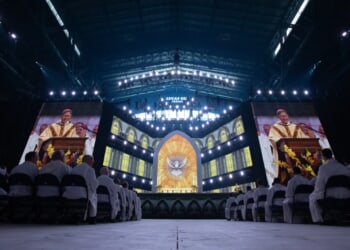The futuristic city of NEOM was supposed to be the crown jewel of Saudi Arabia’s turn toward a more advanced and diverse economy, but eight years into the project, the Financial Times revealed, cost overruns and engineering failures are piling up.
The Financial Times (FT) all but pronounced last rites over NEOM, calling it a “dream unraveled” in a lengthy article last week that made it clear almost everything has gone wrong – from the rude discovery that hanging a 30-story building from a titanic arch was a lot harder than concept designers thought it would be, to the biggest rookie mistake of architects since time immemorial: forgetting that poop flows downhill. The executive director of the project decided to build a network of hundreds of shuttle cars to handle the pungent fruit of NEOM’s thousands of toilets.
The chandelier building was the brainchild of a designer named Olivier Pron, who also did design work on a few Marvel superhero films. He was reportedly brought onto the project because Crown Prince Mohammed bin Salman (MBS), the godfather of NEOM, liked those movies.
The signature element of NEOM – the building that appeared in mind-blowing concept art that captured the world’s imagination eight years ago – is a “linear city” known simply as The Line. It resembled a glass skyscraper tipped on its side, a high-tech version of the Great Wall of China rendered with mirrored glass, a hundred miles long and almost a quarter-mile high.
The Line was designed to be so huge that it would contain an indoor marina big enough to handle massive cruise ships, so enormous that a stadium big enough to handle the 2034 World Cup would overlook the sheltered harbor.
Eight years after all of this was visualized, cost overruns have eaten up $50 billion and produced little more than a forlorn construction site. International investors no longer seem to believe the city of the future will truly be built and top Saudi officials now speak of NEOM as a “multi-generation development.” Some of the project’s insiders told FT that management is looking for a way to “gently” tell MBS that his prized geography-defying science-fiction metropolis will never be completed.
There will be no easy way to tell the de facto chief executive of Saudi Arabia that the naysayers were right all along. The whole point of NEOM, in MBS’ telling, was to show the world that Saudi Arabia could invest its oil wealth into cutting-edge technology and build something that seemed impossible. MBS took what seemed like an impressive plan for a new city and turned it into an arcology, a self-contained metropolis of incredible dimensions, twice as long and twice as high as his engineers and architects recommended.
There were supposed to be people living in NEOM by 2025, and the first phase, which would have been among the largest construction projects in the world on its own, would be completed five years later. The entire structure was projected to cost $1.5 trillion in 2021.
The cost estimate has tripled since then, and exciting big dreams have crashed into various uncomfortable realities. The world might not be able to produce enough steel and cement to complete the original design; one former NEOM employee told FT that the annual cement production of France would be barely enough to build the 20 “modules” that were due by 2030, and there was no way to ship the cement to NEOM quickly enough.
The first phase of the project was dramatically scaled back, to three “modules” instead of 20 – at which point investors lost interest in the entire project because the revised first phase could not accommodate enough people to make the city viable.
One former employee described the scaled-down project as “uninvestable” and a lot of the money already committed to construction has been spent in ways that cannot be audited. Most of the project managers are still afraid to admit failure, even as it grows difficult to pretend that anything close to MBS’ original vision will ever be constructed.
The sad current state of affairs is that massive foundations have been laid for stupendous structures that will probably never be built, a tribal village in the area appears to have been razed for nothing, some of the tribesman are in prison for protesting against construction that will never be completed, and even the airport project stalled out because a mountain is blocking one of its proposed runways.
The Times of London on November 1 quoted a Saudi official who said, “We spent too much. We rushed at 100 miles an hour. We are now running deficits. We need to reprioritize.”
The official was talking about NEOM and all of Saudi Arabia’s other flashy “gigaprojects,” including a mountain ski resort that was to be located near NEOM, a lavish new downtown district for Riyadh, and a Red Sea island resort and superyacht marina called Sindalah.
Part of the problem is that MBS wrote his “Saudi Vision 2030” plan for transforming the Kingdom to a post-oil economy with the assumption that oil would hover around $100 per barrel, but it fell below that threshold in 2022 and might not see triple digits again for years. With only about 60 percent of the funds anticipated by Saudi Vision 2030, the government is shifting its priorities to technology investments like AI and smaller projects with firm short-term completion dates.
“We had a weakness – hype and glitz. I call it the Dubai disease. We picked it up from Dubai. Everything became a glitzy video,” a Saudi business leader grumbled to the Times.

















